General Grabber AT2 and Firestone Destination AT, as the name indicates, are both All-Terrain tires, which are focused on providing a balance between on and off-roading performances. However, AT2 due to its widely spaced tread design marginally provides better off-road traction compared to its counterpart AT who is more suitable for on-road driving experience due to its closely packed tread design.
AT2 has better-built strength and aggressive design providing an extra boost while exploring off-road. For a detailed analysis of the performance of these tires on different terrains, keep reading till the end.
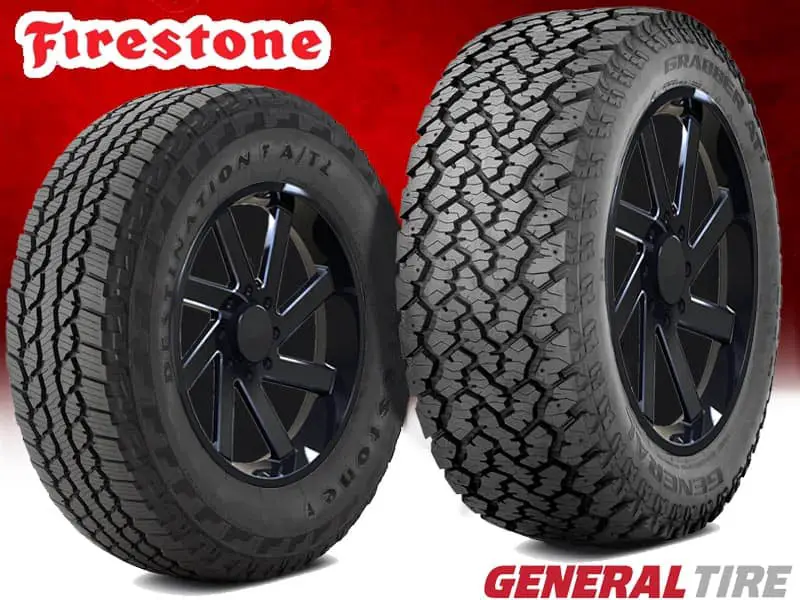
Table of Contents
Comparing Firestone Destination AT with General Grabber AT2
General Grabber A/T2

Firestone Destination A/T
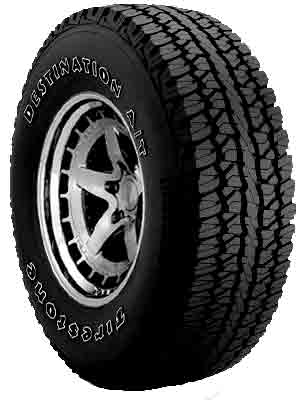
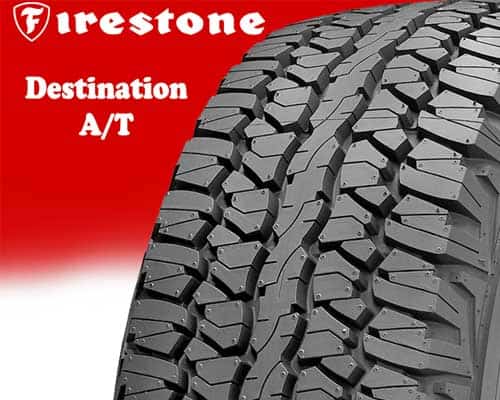
Vs
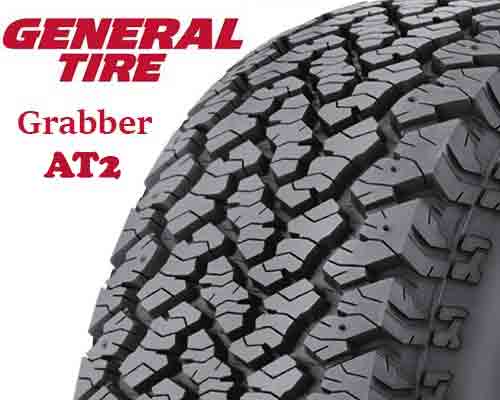
General Grabber AT2 has an aggressive symmetrical computer-optimized design with five rows of sparsely placed tread blocks providing wide and deep grooves between them which ultimately reduces its on-road performance. Its tread blocks feature traction edges and multiple sipes for better grip on wet roads. Wide grooves do allow the efficient removal of mud, soft snow, and debris, bolstering its off-road traction. The wide shoulder design does come in handy during mud traction as it allows mud to easily pass through it. The tire lacks proper traction on ice as there is no decent contact area and due to its shallow sipes. It also introduces bold stone ejectors for better rock traction. The highly optimized shoulder design also provides good handling during off-roading. It has higher built strength and treadwear resistance that improves its durability and mileage. It’s louder on road compared to its counterpart but exceeds in off-road driving comfort due to the shock dampening ability provided by its wider grooves.
Firestone Destination AT tread pattern is engineered to provide good on-road traction along with mild off-road performance. It features a non-aggressive symmetrical tread design with continuous central rib surrounded by separated tread blocks. The central rib is for providing the extra grip during on-roading while the tread blocks wrapped around the rib are for providing the necessary off-road traction. This special blend of on and off-road traction tread blocks pattern is known as “UNI-T” technology utilized by Firestone. It has fewer sipes compared to other tires, decreasing its wet traction. The grooves are narrow and don’t offer much depth which hinders its mud, soft snow, and gravel traction capabilities. On the ice, the tire performs exceptionally well due to its higher contact patch with the road and deeper sipes allowing it to firmly grasp the icy roads. It uses an innovative compound named “Long Link Carbon” which is stronger and does provide extra resistance against treadwear abrasion, improving the durability and mileage of the tire. Its enhanced built material still lacks the toughness and resistance like that of AT2. Its noise cancellation ability is higher due to the lower void ratio but the same decreases its ability to navigate smoothly on uneven terrain.
On-Road Traction Comparison
AT2 tread has a lower contact area with the road causing less grip to be acquired, increasing its braking distance. This negatively affects the on-road traction of this tire making it second to that of AT tire.
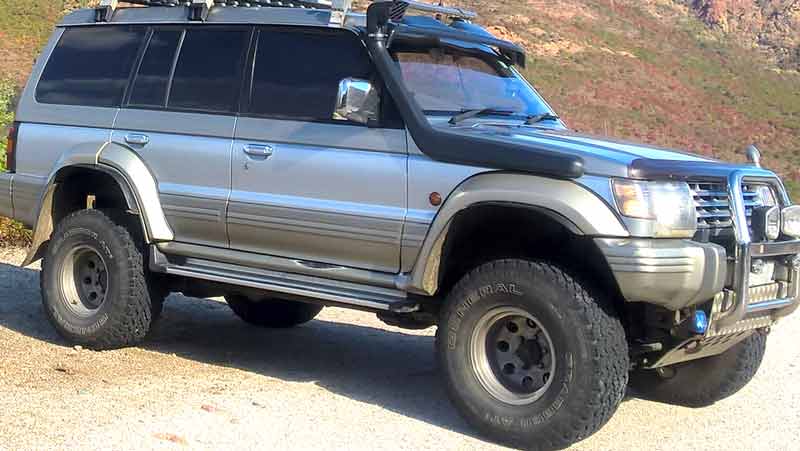
Contradictory to dry traction, its performance in wet conditions is much better. The wider grooves combined with numerous sipes allow water to easily pass through them, making it a better option for driving in wet conditions.
AT is somewhat focused on reliable on-road performance by adding a continuous rib which provides that extra boost to on-road traction by increasing the contact patch of the tire. This improves the grip, thus resulting in overall better on-road dry traction. Narrow grooves and fewer sipes are average in wet traction, as they perform adequately to avoid hydroplaning but are not preferred to tackle severe wet conditions.
Off-Road Traction Comparison
Mud Terrain
Wider grooves of AT2 allow smooth navigation of vehicle through the mud as it can easily evacuate the mud by throwing it backward, hence moving the tire forward.
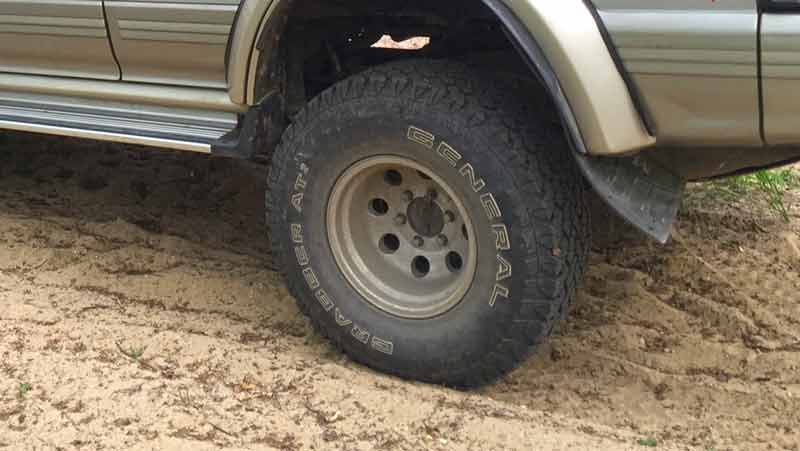
The open shoulder design of AT2 further assists in the efficient traction of mud by allowing the mud to seemly pass through its wide shoulder stud grooves, resulting in a much efficient tire on mud.
AT has narrow grooves comparatively that can throwback mud and make its way through the muddy terrain but are not preferable in heavy mud as the narrow grooves are not well equipped to handle heavy mud efficiently. The grooves will fill with the heavy mud, making the tire lose its grip and turn it into a slick.
Snow Terrain
AT2 has wider grooves which allow efficient traction in soft snow as they can effectively grip and throwback the soft snow keeping the tire moving. However, on ice the traction is very reduced due to lower contact patch and shallow sipes, this results in the slipping of tire on icy roads.
AT on the other hand struggles on soft snow as its grooves are not wide enough to effectively grip soft snow and may cause the tire to get stuffed with snow, rendering them useless. The ice traction is far better because it has a higher contact patch and deeper sipes providing good grip allowing the vehicle to propagate boldly on ice.
Rock terrain
Bolder stone ejectors provide an extra performance bonus to AT2 on rocks as they can effectively avoid the stones/pebbles from getting stuck inside the grooves since they could drill through them. The strong built of the tire protects it from trail damages like cuts and chips and allows the vehicle to confidently navigate on rocks. The wider grooves provide a good grip on tricky angles of approach on rocks.
The smaller stone ejectors in AT are not efficient enough to compete with its counterpart. They don’t eject all the stones from grooves which pose the threat of remaining stones and pebbles drilling into the tire. The weaker built strength further decreases the tire dependency on rocks due to its inability to effectively resist the harsh conditions posed by the rocky terrain.
Durability and Treadwear Differences
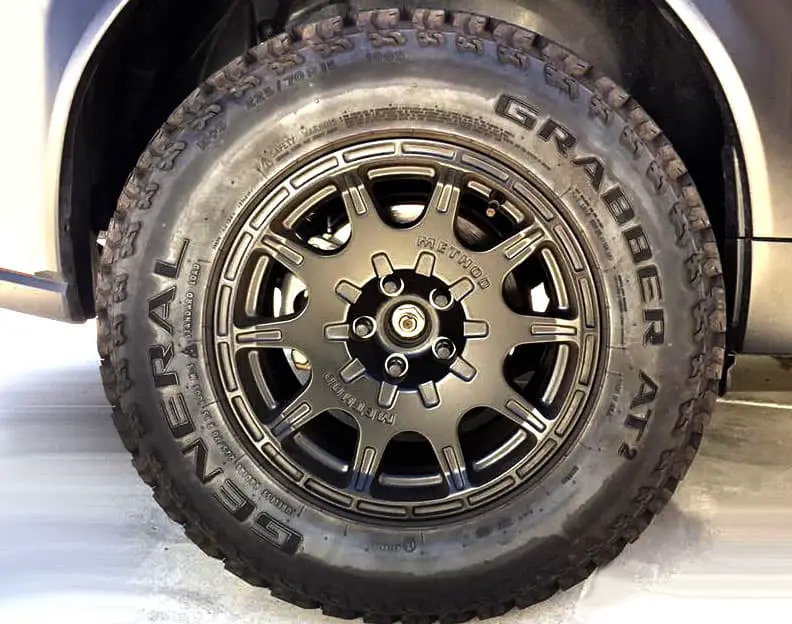
The lower contact patch of AT2 is responsible for creating lower rolling resistance which is the force required to keep the tire rolling. Lower rolling resistance leads to reduced treadwear of the tire, making its durability higher and making the tire last longer. Its stronger built further decreases the treadwear by making the tire more resistant to wear and tear. The tire consists of chips and a tear-resistant tread compound along with two steel belts on the top of the skeletal polyester body. This makes the tire built extra solid and reliable which makes its mileage higher compared to AT.
AT having a higher contact area with the ground causes there to be more friction, thus increasing its rolling resistance. Since more force is required to keep the tire moving, it will directly impact its durability, because the treadwear is increased by higher rolling resistance. It is made up of a long link carbon compound to increase its tread strength but it’s still weaker than that of AT2. The weaker built further decreases its durability as it lowers the tire treadwear resistance. All these factors result in the much lower mileage of the tire compared to its competitor.
Which Tire is more Comfortable?
The on-road comfort is directly linked to the quiet running of the tires. AT2 being the more off-road capable tire struggles to maintain comfortable on-road drive as the wide grooves are a source of loud noise during high-speed travel. The back and forth striking of air particles stuck inside the grooves are responsible for producing this noise. While off-roading the wider grooves act as shock absorbers, dampening the impact of jerks as it moves through uneven terrain. This makes the off-road comfort of the tires higher as they allow much smoother navigation.
The AT on other hand offers great comfort while traveling on-road as the narrow grooves don’t produce much noise during high-speed travel as lesser particles get trapped inside the grooves and only produce neglectable noise. But its off-road comfort is certainly decreased to the inability of narrower grooves to effectively absorb the jerk during passing through rough terrain, making the off-road journey terrible.
Price Differences
AT2 is a higher-priced tire simply because it offers more features supporting off-road experience, stronger built, and higher mileage of the tire. Destination AT is however focused on a more balanced approach with better on-road traction due to its unique tread design and provides an average level of performance off-road. Customers should choose one of these tires based on their preferences and needs.
Quick Summary
- Both are All-terrain tires.
- AT performs well on-road while AT2 performs better off-road.
- AT2 has somewhat better-wet traction
- Soft snow, mud, gravel traction of AT2 is better due to wider grooves.
- AT performs better on ice due to the larger contact patch.
- Bold stone ejectors give an edge to AT2 over AT.
- The durability and treadwear resistance of AT2 is higher.
- AT2 is a higher-priced tire compared to AT.


